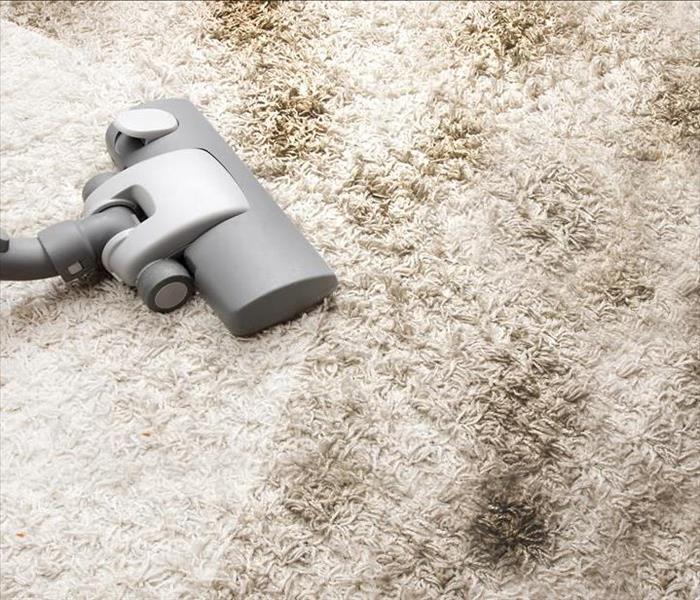Carpet Cleaning Flagler - You'll be surprised to learn how much dirt vacuums miss -- and how simple the best cleaning methods really are.
12/16/2014 (Permalink)
The pitch was simple. In the 1950s, a vacuum salesman would come to the door, spill dirt on the carpet, and ask the lady of the house to clean it with her machine. Then he would load a fresh bag into his model, run it over the "clean" carpet, and open the bag to reveal what it had picked up. Frequently that was all he needed to close the deal. Had the salesman reversed the order, however, using his machine first, the results might have been the same. Often the problem wasn't the old vacuum. It was the fact that once dirt goes into carpet, it doesn't easily come out.
Out of the Carpet and Into the Air
The dust that collects in carpets may contribute to health problems -- particularly asthma, the most common chronic disease among children. Many vacuums worsen the problem by sending that dust shooting into the air, but a relatively new breed uses HEPA (high efficiency particle arresting) filters to trap essentially all of it in the machine.
When the Carpet and Rug Institute, a trade group, tested vacuums' effect on air quality, it found that just having a HEPA filter doesn't necessarily mean the machine is a clean one. The beater brush may still stir up dirt that becomes airborne. To be awarded the group's "green label" a vacuum cannot cause dust in the air to exceed 100 micrograms per cubic meter -- less than the amount of dust a person generates by scratching his head a few times.
How to Clean Your Carpets
Carpet Type: Synthetic
Routine Care: Vacuuming -- Remove grit with multiple passes in varying directions. Use the beater brush, set to the pile height. Change bag when one-half full because efficiency decreases after that. Liquid Spills -- Clean promptly, using the blot technique described below. If the area discolors, there's probably a sticky spill residue that has trapped soil. Clean by misting with warm water and blotting.
Deep Cleaning on Your Own: Professional steam cleaning works best on wall-to-wall carpeting and may be required by the warranty. If you want to do it yourself, vacuum thoroughly, then use an extraction machine from a rental company (supermarket models are less powerful). Test cleaning solution by pouring a few drops into a saucer and allowing to evaporate (a hair drier speeds the process). If the dried residue in the saucer remains sticky, switch cleaners. Use fans or air-conditioning to dry carpet. Area rugs can be cleaned using the same methods.
Carpet Type: Wool
Routine Cleaning: Vacuuming -- Follow the instructions above, but avoid using a rotary brush on loop-pile (Berber) carpets; the yarn may fuzz. Instead, use a floor tool. Liquid Spills -- Clean by misting with water and blotting, as for synthetic carpets. Never use ammonia or any other highly alkaline cleaner, which can damage wool.
Deep-Cleaning On Your Own: For both area rugs and wall-to-wall carpets, home cleaning is not recommended because wool fibers absorb more water than synthetic fibers do. This makes them hard to dry, and area carpets become very heavy and difficult to maneuver. Plus, a lot of the available cleaners are too alkaline. Many of today's carpets, however -- even Oriental-style ones -- are actually made from synthetic fibers. To test for wool, snip a strand, and hold a lit match to it; burning wool smells like burned hair.
Carpet Type: Plant
Routine Cleaning: Vacuuming -- Use the same technique as for synthetic carpets. A beater brush is the best way to remove grit, which causes excessive wear on these carpets. Liquid Spills -- Plant fibers are less stain-resistant than synthetics or wool, even if they have been treated with a water repellent, so blot spills promptly, following instructions below. Make sure damp areas dry quickly by using a fan or a hair drier (set on low heat).
Deep Cleaning On Your Own -- Manufacturers recommend the use of dry methods only. Leave that to a professional. You’ll be surprised to learn how much dirt vacuums miss -- and how simple the best cleaning methods really are.
Keeping Clean
Limit how much dirt gets into carpets in the first place. Declare a shoes-off rule, or place sturdy doormats at all entries.
Frequent vacuuming is the only way to keep grit from becoming embedded. Having a vacuum that's easy to use is crucial. Spend the bulk of cleaning time where dirt collects: a dozen passes of the vacuum within 4 feet of outside doors, eight passes in high-traffic areas, and four passes elsewhere. Where carpets have not been regularly and thoroughly cleaned, double the passes for three months.
The safest, easiest, and most effective deep-cleaning solution for area rugs is to have them rolled up and taken away for cleaning. With wall-to-wall carpeting, truck-mounted, hot-water extraction -- or steam cleaning -- works best. Cleaning rugs or carpets yourself with a rented extraction machine is fine as long as you don't leave the carpet too wet and don't use too much cleaner. You’ll be surprised to learn how much dirt vacuums miss -- and how simple the best cleaning methods really are.
SERVPRO of Flagler County serves the Palm Coast, Flagler Beach, Hammock Dunes, Beverly Beach, Bunnell, Marineland, Hammock, Hammock Beach and the surrounding North East Florida communities.
Call us at 24/7 at 386-447-2202





 24/7 Emergency Service
24/7 Emergency Service
